- Introduction
- Immersive Digital World and the Revolution in Education and Learning
- Virtual Classes and Simulations
- Education in Dangerous and Complex Environments
- Education in Diverse Settings
- The Impact of the Immersive Digital World in Healthcare
- Environmental Care and Social Awareness
- Progress and Expansion of Social Inclusion
- Transformation in Business and Industry
- Advances in Scientific and Technological Research
- Immersive Digital World: Innovation in the Virtual World or a New Reality?
- The Impact of the Immersive Digital World on Social Relations and Human Interaction
- Immersive Digital World: A Platform for Employment Opportunities and
- Economic Development
- The Connection Between the Metaverse and the Physical World: Coexistence or Competition?
- The Immersive Digital World and Cultural Impact: Do Identities Change in the Virtual World?
- Security and Privacy in the World of Legal and Technical Challenges
- Conclusion
Introduction
The Immersive Digital World (Metaverse) is an emerging and advanced technology that is rapidly expanding and increasingly impacting various aspects of human life. These virtual worlds, built using technologies such as Virtual Reality (VR), Augmented Reality (AR), and digital simulations, can directly and indirectly transform lives and affect economic, social, environmental, and cultural dimensions. The Immersive Digital World provides new ways for education, healthcare, work, and even recreation while addressing global issues such as climate change, social inequality, and health crises.
In this article, we will examine how the positive and transformative impacts of the Immersive Digital World are affecting the real world and demonstrate how this technology can play a role in improving human quality of life.
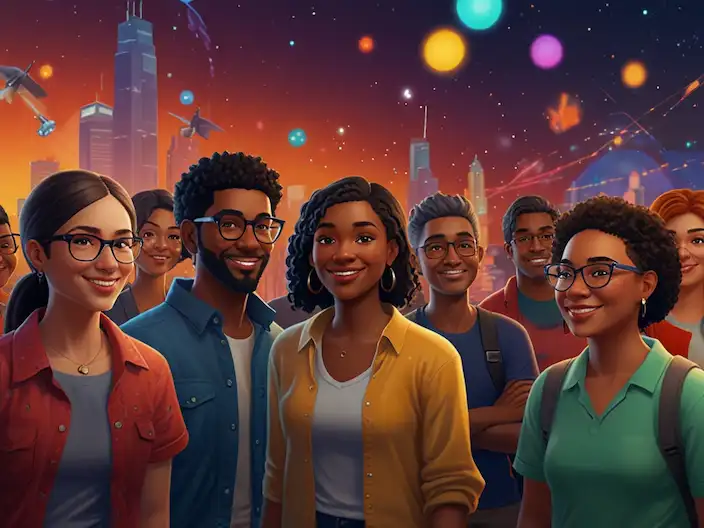
The Immersive Digital World and the Revolution in Education and Learning
The Immersive Digital World has brought about remarkable changes in education, particularly in specialized and practical fields. This technology has completely transformed teaching and learning methods and helps create an engaging, interactive, and realistic space for students.
- Virtual Classes and Simulations
Virtual and augmented reality have been added to traditional education, providing more learning opportunities. For instance, students can interactively engage with subjects such as history, science, or geography in a virtual world. This technology is especially effective in teaching medical and engineering disciplines. In these fields, simulations and immersive experiences allow students to explore complex processes in a controlled environment.
- Education in Dangerous and Complex Environments
In high-risk industries like oil, gas, or rescue operations, immersive training environments allow individuals to develop their skills without encountering real dangers. These technologies help users learn necessary skills in real-life conditions without physical vulnerability.
• Education in Diverse Settings
Learning through the Metaverse offers students the opportunity to interact with each other at any time and from any location. Since these spaces allow for both live and recorded classes, students can easily access educational materials and resources.

The Impact of the Immersive Digital World in Healthcare
The Immersive Digital World has created a significant transformation in healthcare. Technologies such as VR and AR have enabled doctors and specialists to provide treatment and counseling in more effective and innovative ways.
- Telemedicine and Virtual Counseling
During the COVID-19 pandemic, the use of telemedicine systems for patient consultations and symptom assessments greatly increased. In these spaces, doctors can evaluate patients’ conditions and prescribe treatments through digital platforms.
- Mental Health Treatments
For treating psychological disorders such as PTSD, anxiety, and stress, VR is used to simulate specific situations. This allows patients to confront their fears and issues in a safe and controlled environment.
- Pain Management
Another application of the Immersive Digital World in healthcare is pain management. VR has proven effective in reducing chronic pain. Patients can enter the virtual world and experience interactive sessions that relieve pain and even reduce their reliance on pain medications.
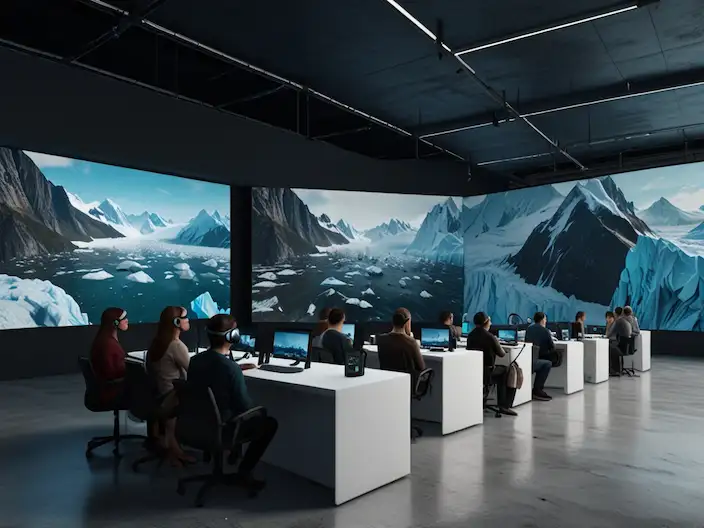
Environmental Care and Social Awareness
Immersive technologies not only improve human life but also have significant applications in environmental protection and addressing environmental crises. By using detailed simulations of virtual environments, people can experience the impacts of climate change and global crises.
- Awareness of Climate Change
The Immersive Digital World is effectively used to raise global awareness about environmental crises. Through digital simulations, the immediate and long-term effects of climate change, such as polar ice melt, rising sea levels, and the resulting crises, can be clearly demonstrated. These simulations increase global understanding and empathy for tackling environmental challenges.
- Assisting in Environmental Planning
Governments and organizations can use the Immersive Digital World to simulate environmental conditions and design models to tackle climate change and environmental crises. These models help urban planners and international organizations make effective decisions for environmental protection.

Progress and Expansion of Social Inclusion
The Immersive Digital World can promote social inclusion and eliminate barriers to accessing opportunities. These technologies allow individuals in remote and disadvantaged areas to access education, healthcare, and employment opportunities.
- Equal Access to Services
One of the key advantages of the Immersive Digital World is its ability to bridge gaps in access to social services. People in remote areas can access educational, healthcare, and employment services through virtual platforms.
- Increasing Social Empathy
Immersive experiences help individuals develop a better understanding of others’ social issues. These experiences can create greater awareness of social problems such as poverty, discrimination, migration, and economic inequality, leading to increased empathy and cooperation among people.
Transformation in Business and Industry
The Immersive Digital World is rapidly transforming business and industry as well. These technologies are used to create virtual work environments, trade shows, business events, and even product designs. In business and industry, these transformations are especially evident in e-commerce, customer service, and digital marketing. Companies use the Metaverse to create immersive experiences for customers, enabling them to interact with products and services in simulated, engaging environments. For example, fashion brands use virtual environments to host online fashion shows, which enhances marketing and attracts more customers.
- Remote Work and Global Collaboration
Especially during the COVID-19 pandemic, the Immersive Digital World allowed companies to work remotely. Collaboration in global teams became easier, increasing productivity while reducing the need for travel.
- Virtual Business Events
Companies and organizations use the Immersive Digital World to host trade shows, conferences, and business events. These events allow companies to present their products to a global audience.
- Product Design and Prototyping
Companies leverage immersive technologies to design and develop products, reducing waste and improving production processes.
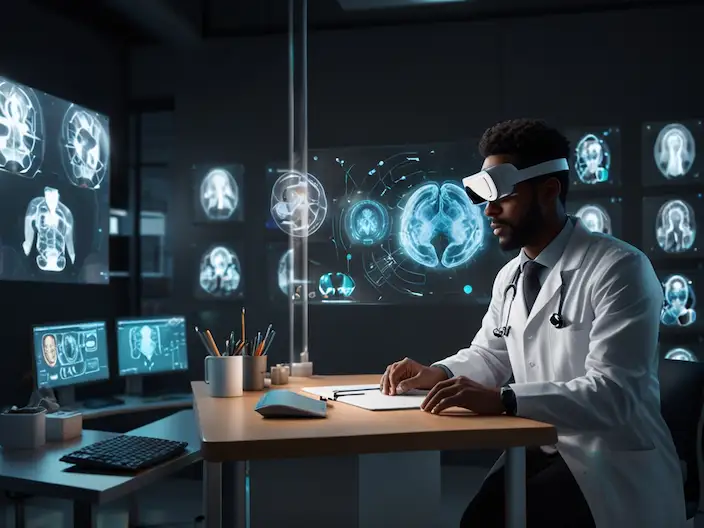
Advances in Scientific and Technological Research
Another benefit of the Immersive Digital World is its support for advances in scientific research. Researchers can use simulated environments to test hypotheses and analyze results. In scientific and technological advancements, one exciting application of the Metaverse is facilitating international collaborations and joint research in large-scale projects. Especially in medical sciences, researchers can collaborate virtually in laboratories around the world, sharing scientific data in real-time. This type of collaboration can lead to faster advancements in fields such as disease treatment, drug development, and even space exploration. Overall, these advancements not only enable faster research and innovation but also provide solutions for global challenges like climate change or pandemic diseases.
- Simulated Research
Researchers can conduct experiments in a digital environment that may not be possible in the real world. For example, scientific experiments in special conditions can be carried out in a digital space without the high costs or risk to individuals.
- International Collaboration in Research and Development
The Immersive Digital World creates more opportunities for international collaboration. This allows researchers worldwide to cooperate and engage in joint scientific projects.
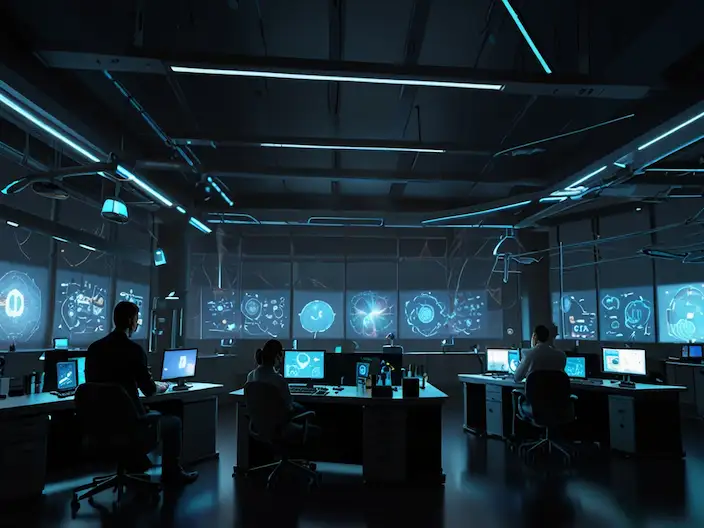
The Immersive Digital World: Innovation in the Virtual World or a New Reality?
The Immersive Digital World, commonly known as the Metaverse, may initially seem like a technological innovation or a virtual entertainment space, but in reality, it is rapidly changing many aspects of human life. The Metaverse, using VR, AR, and digital simulations, creates an entirely new space for interactions and experiences that often blur the lines between the real and virtual worlds. This new world not only provides opportunities for entertainment and social interaction but is also a tool for transformation in education, business, and even healthcare.
In fact, the Metaverse is not just a technological innovation but has become a new reality where physical and geographical boundaries for human interactions, communication, and information exchange are minimized. This transformation has massive implications for the future of work, education, and social life.

The Impact of the Immersive Digital World on Social Relationships and Human Interactions
In the immersive digital world, social interactions have undergone a complete transformation. Humans are no longer bound by geographical or temporal limitations to communicate with each other. In the metaverse, individuals can interact with others in real-time by being present in virtual spaces, sharing their views, and even working on joint projects without the need for physical presence in a single location.
On the other hand, the metaverse can be particularly effective for different social groups, including those with special needs, in fostering a sense of belonging and social participation. For example, individuals with disabilities can experience new social interactions in the immersive digital world that may be difficult or impossible for them in the real world.
However, these changes also lead to challenges. In this space, the boundaries between individuals’ real and virtual identities may blur, which can have consequences for identity formation and a sense of belonging to the real-world community. Therefore, examining and analyzing these changes is of great importance.
The Immersive Digital World: A Platform for Job Opportunities and Economic Development
One of the greatest potentials of the metaverse is its ability to create job opportunities and foster economic development on a global scale. Especially in the post-pandemic era, many jobs have moved toward virtual spaces and remote work. In this regard, the immersive digital world can serve as an innovative platform for education, skill development, and international collaboration.
As the metaverse allows companies to create virtual work environments, they can utilize its capabilities for meetings, team sessions, and even professional training. This could provide opportunities for growth and expansion, especially for small and medium-sized businesses that may have fewer resources.
Furthermore, the immersive digital world has created new markets for goods and services, where products are directly sold in virtual environments. This new space can be an excellent solution for generating income and employment in the future world.
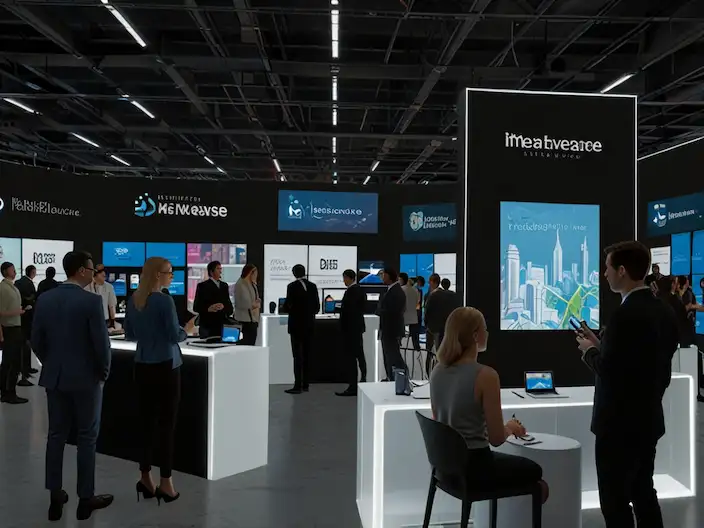
The Relationship Between the Metaverse and the Physical World: Coexistence or Competition?
One of the main challenges that need to be addressed in the development of the immersive digital world is its relationship with the physical world. Can the metaverse replace real life, or will it merely complement it? Many experts believe that the metaverse and the physical world are not only not competitors, but they can coexist and complement each other.
This is particularly evident in areas like education and healthcare. In these fields, the immersive digital world acts as an effective complement to the physical world. For example, in medicine, doctors can use digital simulations for training and disease analysis while providing real treatments in the physical world for patients.
Ultimately, the immersive digital world can blur the boundaries between these two realms by creating new interactions, allowing them to coexist and function simultaneously.
In the context of the metaverse and the physical world coexisting, we are witnessing a form of synergy that improves various aspects of human life. For example, in education, the metaverse enables students to virtually visit complex physical environments such as laboratories, museums, and even historical sites, providing them with an interactive and educational experience. These experiences can be more profound than simple online classes because individuals can interact with first-hand concepts and information in virtual spaces.
In business, especially in service industries and online sales, the metaverse allows companies to offer services to customers virtually using 3D simulations, without requiring physical presence in stores or offices. This type of interaction not only speeds up processes but also reduces operational costs.
In healthcare, the metaverse can serve as a complementary tool to traditional physical treatments. For example, in sports or orthopedic injury treatment, doctors can use simulated environments to train patients and diagnose complex conditions. The synergy between the two realms—physical and virtual—ensures that, especially in medical fields, treatment processes are faster and more effective.
The Immersive Digital World and Cultural Impacts: Are Identities Changing in the Virtual World?
A notable issue in the immersive digital world is its impact on individuals’ cultural identities. In the virtual world, people can create new digital identities that may differ significantly from their real-world identities. This allows individuals to experience new things and even transcend the social frameworks that exist in the real world.
While this feature can help individuals have more freedom in shaping their identities, it may also bring about challenges. In the digital world, cultural and social differences may be easily overlooked, leading to misunderstandings and cultural tensions.
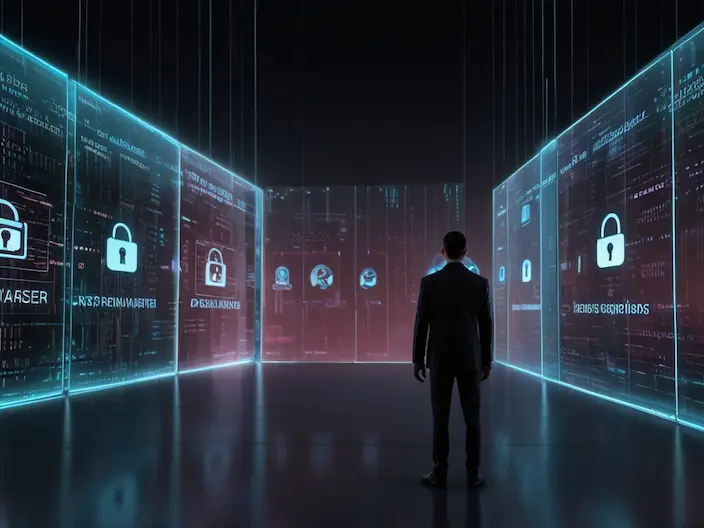
Security and Privacy in the World of Legal and Technical Challenges
With the expansion of the immersive digital world, many concerns have arisen regarding security and privacy. In the virtual world, users expose their personal information to risk, and this information may fall into the wrong hands. This is particularly critical when financial, social, or professional interactions take place in these spaces. Therefore, maintaining security and privacy is essential.
Governments and companies must work to employ advanced security technologies to protect personal data and safeguard against cyber threats. Furthermore, new laws must be enacted to monitor and manage this digital space to prevent potential abuses.
Conclusion
The immersive digital world is dramatically changing various aspects of human life and offering new possibilities to improve quality of life. From education and healthcare to business and the environment, these technologies hold great potential for creating positive changes in the real world. As these technologies continue to advance and develop, the immersive digital world could become a powerful tool to address global challenges and create a better future.
Ultimately, the metaverse, as an emerging technology, has tremendous potential for significant transformations in humanitarian and social projects. Especially in fields such as education, healthcare, and helping needy communities, the metaverse could become a tool for facilitating access to essential services and resources. This space could give people in remote areas, who traditionally have been deprived of services due to geographical or economic challenges, access to information and educational resources. Additionally, in humanitarian projects, the metaverse could serve as a platform for collecting public donations, raising awareness, and even simulating crises for better community preparedness. Consequently, this technology will not only create changes in the business and scientific world but also act as a positive force in advancing social and humanitarian goals.
Table of Contents
Toggle
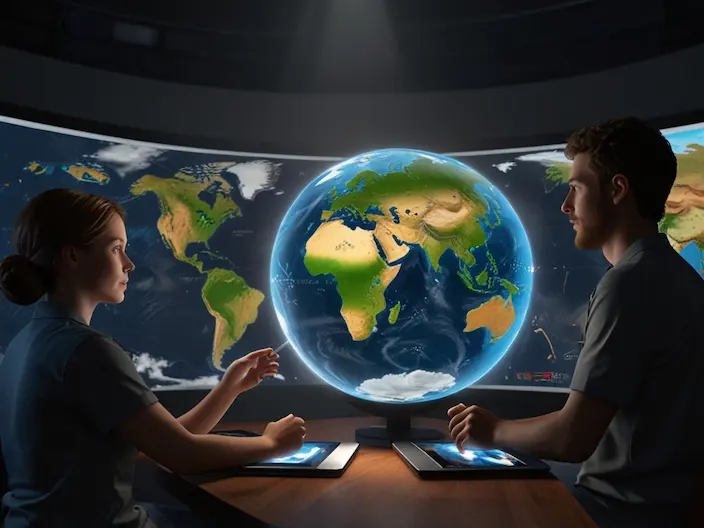

One Response